Getting a Sugar Glider: Essential Ownership Guide
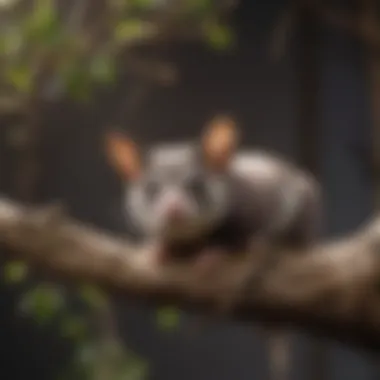
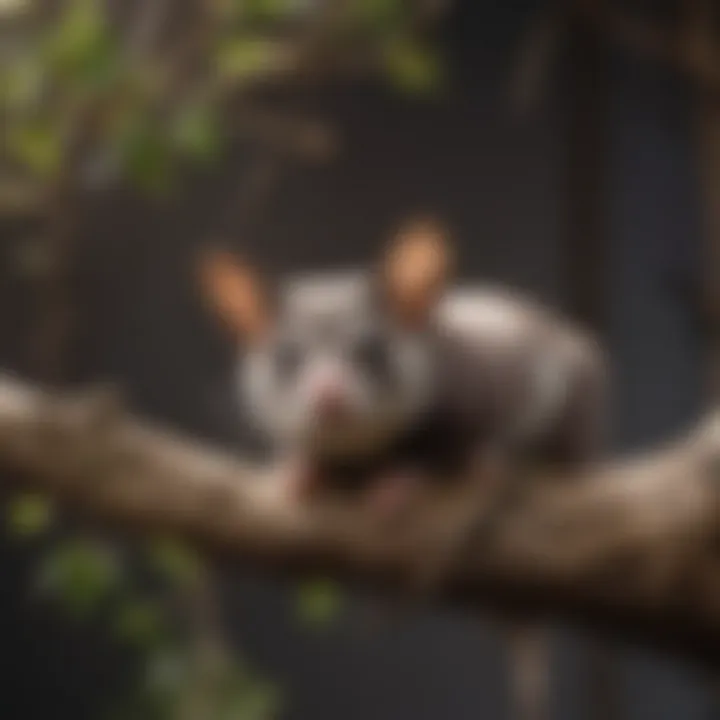
Intro
Acquiring a sugar glider as a pet requires careful consideration and preparation. These small, nocturnal marsupials have unique needs that differ significantly from more common domestic animals. This guide aims to provide potential sugar glider owners an extensive overview of what to expect, how to prepare, and how to ensure the well-being of their new companion.
In this guide, we will explore essential care tips, behavioral insights, nutritional needs, health management, and enriching activities that can contribute to a healthy and fulfilling life for both the sugar glider and its owner. Understanding these aspects increases the chances of a successful and enjoyable partnership.
Care Tips
Daily Care Routines
Sugar gliders need daily attention and routine to thrive. Regular handling helps build trust and facilitates socialization. Spend at least an hour each day interacting with your sugar glider. Routine should also include feeding, cleaning, and checking the health of your pet.
Cage Setup and Maintenance
The cage for a sugar glider should be spacious and equipped with climbing opportunities since they are arboreal creatures. A minimum of 24 x 24 x 36 inches is recommended. Include items such as branches, hammocks, and toys to encourage natural behaviors. Maintenance involves cleaning the cage every few days to prevent odors and maintain hygiene.
Hygiene and Cleaning Practices
Regular cleaning of the cage eliminates waste and reduces the risk of illness. Spot clean daily by removing uneaten food and droppings. A thorough cleaning should occur weekly, using safe, pet-friendly cleaning solutions to sanitize surfaces.
Seasonal Care Adjustments
Changes in temperature can affect a sugar glider's health. In warmer months, ensure they have plenty of fresh water and shade. During colder months, provide extra bedding and ensure they are kept warm enough since sugar gliders are sensitive to drafts.
Behavioral Insights
Understanding Sugar Glider Body Language
Observing body language is essential in understanding your sugar glider. For example, an excited sugar glider may engage in play or glide, while a stressed one might hiss or retreat. Learning these signals helps you better respond to their needs.
Common Behavioral Issues and Solutions
Behavioral issues can arise, such as biting, which is often a result of fear or stress. Building trust through gradual interaction can alleviate these issues. Avoid sudden movements that may frighten them.
Positive Reinforcement Techniques
Using treats to reward desired behavior is an effective way to train your sugar glider. For instance, encourage them to come to you by using their favorite fruit as an incentive. This positive reinforcement builds a stronger bond.
Social Interaction Needs
Sugar gliders are social animals and generally thrive in pairs or small groups. If considering a sugar glider, think about adopting one or two. They can keep each other company and reduce feelings of loneliness.
Nutrition Guides
Essential Diet Components
A balanced diet crucial for sugar gliders includes fruits, vegetables, and a protein source. Fresh fruit like papaya, mango, and various leafy greens should be their primary food source.
Safe and Toxic Foods
Be aware of foods that are safe and those that can harm your sugar glider. Avoid avocado, chocolate, and caffeine, as they can be lethal. Educating yourself on what to include in their diet is vital.
Supplements and Treats
Consider providing supplements like calcium to ensure proper nutrition. Treats like dried fruits should be given sparingly to prevent obesity. Moderation is the key here.
Feeding Strategies for Different Species
Different sugar glider species might have distinct dietary needs. Research appropriate diets specific to your sugar glider's species to promote optimal health.
Wellness and Health
Routine Health Checkups
Regular vet checkups are essential to monitor your sugar glider's overall health. A veterinarian experienced in exotic pets can provide the best care and suggest preventative measures.
Identifying Symptoms of Illness
Be observant of changes in behavior, appetite, or appearance. Symptoms like lethargy or a decline in grooming habits may indicate health issues. Early detection can be crucial.
Preventative Care and Vaccinations
Consult with your vet about necessary vaccinations and preventative care. Creating a healthcare regimen can significantly impact your sugar glider's quality of life over time.
Mental and Emotional Well-being
Sugar gliders require mental stimulation as much as physical care. Regular playtime and social interaction contribute positively to their emotional health.
Enriching Activities
Toys and Playtime Ideas
Invest in a variety of toys that encourage physical activity. Items like tunnels, ropes, and climbing structures can keep them engaged and active. Changing toys periodically keeps their environment stimulating.
Training and Tricks
You can teach simple tricks to your sugar glider, like coming when called or jumping through hoops. Training can also serve to strengthen the bond between owner and pet.
Outdoor Activities and Interaction
Supervised outdoor time can provide valuable exploration opportunities. Ensure the area is secure and free from potential hazards. Natural sunlight can be beneficial but protect them from direct exposure for long periods.
DIY Projects for Mental Stimulation
Create your own toys or training equipment from safe household materials. For example, simple tunnels can be made from cardboard or plastic bottles, encouraging exploration. Engaging their minds is as important as physical activity.
Understanding the needs and behaviors of sugar gliders is fundamental to ensuring their health and happiness. Invest time in learning before bringing one into your home.
Overview of Sugar Gliders
Understanding sugar gliders is essential for anyone considering adding this unique creature to their home. These small marsupials require specific care and attention, accentuating the importance of being knowledgeable before making a commitment. This section covers the foundational information needed to appreciate sugar gliders as pets and to understand their needs better.
What is a Sugar Glider?
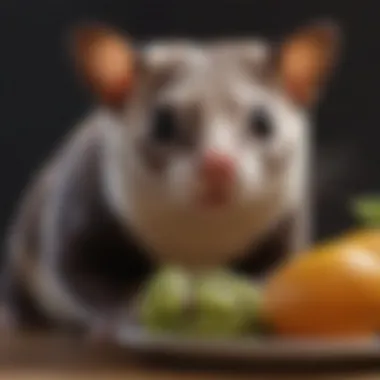
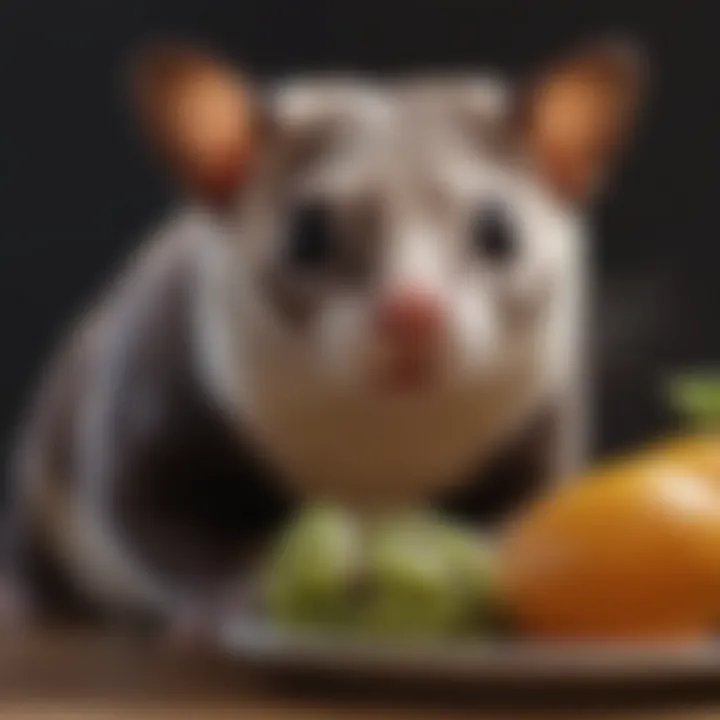
Sugar gliders, scientifically known as Petaurus breviceps, are small, nocturnal marsupials primarily native to Australia and New Guinea. They belong to the family Petauridae. These animals are characterized by their gliding membrane, which extends from their wrists to their ankles, allowing them to glide gracefully through trees in search of food and shelter. Their size is usually that of a small squirrel, averaging about six to seven inches in body length, while their tail can be as long as their body, providing balance during their gliding maneuvers.
These creatures exhibit a highly social behavior and thrive in groups, which is critical to keep in mind when considering them as pets.
Origin and Habitat
Sugar gliders inhabit the forests of Australia, where they blend seamlessly with their environment. Their preferred habitats are the eucalyptus and acacia trees, providing not only shelter but also access to their primary food sources, which include nectar, fruits, and insects. In the wild, they are active during the night, foraging and gliding from tree to tree.
Understanding their natural habitat is vital for setting up an appropriate home environment. Mimicking aspects of their native habitat can benefit their well-being as pets. A suitable habitat setup includes plenty of vertical space, places to climb, and a variety of textures.
Physical Characteristics
Sugar gliders have soft, dense fur that is typically grayish-brown on their backs and lighter on their bellies. They possess large, expressive eyes that aid their vision in low-light conditions, a trait advantageous for their nocturnal lifestyle. Their large ears are also prominent, allowing them to detect sounds that help in locating food or sensing predators.
Their dentition includes sharp teeth, adapted for their varied diet, while their claws are designed for climbing. This body structure aids their agility and versatility in a forested setting. Being aware of these physical characteristics not only enhances understanding but also assists in making informed decisions about their care.
Key Takeaway: Sugar gliders are social, nocturnal marsupials that require a suitable environment to thrive, reflecting their natural habitat and physical traits.
Assessing Suitability as a Pet
Assessing suitability as a pet is an essential aspect of preparing for the ownership of a sugar glider. Understanding the traits, needs, and long-term commitment required for these unique animals is crucial. This section helps prospective owners discern if a sugar glider aligns with their lifestyle and expectations. It truly serves as a foundation for responsible pet ownership, promoting a better quality of life for both the owner and the animal. This knowledge leads to informed decisions, reducing the risk of abandonment or negligence and ultimately enhancing the pet ownership experience.
Behavioral Traits
Sugar gliders are known for their distinct behavioral characteristics. Understanding these traits can shed light on what to expect when welcoming one into your home. They are primarily nocturnal creatures, meaning they are active during the night. This may be appealing to those who are busy during the day but might be a challenge for individuals who prefer quiet evenings.
Their social nature is another important behavior trait to consider. Sugar gliders typically thrive in groups, which indicates that a single sugar glider may experience loneliness. Potential owners should think about adopting more than one if possible. Additionally, they exhibit playful and curious behavior, requiring ample interactive time with their owners or companions.
Being aware of their vocalizations is also key. Sugar gliders can make various sounds to communicate, including chirps, barks, and whistles. Understanding what each sound means helps foster better communication between owner and pet.
Social Needs
The social needs of sugar gliders necessitate careful consideration before making a commitment. These animals are highly social and bonding-focused. Owners should prioritize interaction and companionship. This companionship can come either from other sugar gliders or from their human caretakers.
Regular handling and playtime are essential, as they help develop trust and strengthen the bond. This includes engaging in activities that promote physical exercise and mental stimulation, such as climbing and gliding in a safe environment. Lack of social interaction can lead to stress and behavioral issues, which can dramatically affect their well-being.
It is advisable to limit the amount of time left alone. An ideal owner would spend significant time each day tending to their needs and ensuring they receive enough interaction. Those who travel frequently or work long hours may need to reassess their ability to meet these needs.
Life Expectancy and Commitment
Considering the life expectancy of a sugar glider is vital in the decision to adopt one. On average, they live between 10 to 15 years in captivity. This longevity requires a long-term commitment from the owner. Prospective owners should evaluate their readiness for such a commitment, as these animals rely heavily on their caregivers throughout their lives.
Owning a sugar glider involves continuous responsibilities. Beyond daily care, this includes providing enrichment, proper nutrition, routine veterinary care, and companionship. If an owner is not prepared for this level of involvement, it might be wise to reconsider.
Taking into account life expectancy, it becomes clear that adding a sugar glider to one’s family is not a casual decision. It requires a serious assessment of personal readiness, lifestyle, and the ability to provide a stable environment for many years to come.
"A sugar glider may take time to adjust, but their rewards of companionship and affection can be substantial for those willing to commit."
In summary, evaluating behavioral traits, social needs, and the life expectancy of sugar gliders is paramount when considering them as pets. Understanding these aspects ensures potential owners make an informed decision that leads to a rewarding and enriching relationship.
Legal Considerations
Understanding the legal considerations when acquiring a sugar glider is an essential aspect of responsible pet ownership. Legal regulations help ensure the protection of wildlife and the welfare of the animals themselves. In some regions, sugar gliders are considered exotic pets, which can lead to specific laws governing their ownership, sale, and breeding.
Failure to adhere to these laws can result in fines or the confiscation of the pet. Therefore, potential owners must familiarize themselves with the relevant local and national regulations.
Local and National Regulations
Before acquiring a sugar glider, it is crucial to investigate local laws regarding exotic pets. In some states or municipalities, sugar gliders may be banned or require special permits for ownership. This can vary widely, so potential owners should check with local authorities or animal control agencies to ascertain the specifics.
Different countries have their own approaches to managing exotic pets. For example, some areas may have specific restrictions on importing sugar gliders due to concerns about invasive species. By thoroughly researching these regulations, prospective owners can ensure they are abiding by the law, which ultimately contributes to the better treatment of these animals.
A few key points to consider:
- Prohibition: Some areas outright prohibit exotic animals like sugar gliders.
- Permit requirements: Others may mandate permits or licenses, often necessitating proof of adequate care facilities.
- Wildlife regulations: It’s advisable to understand how sugar gliders are classified in your locale, as this affects their legal status.
Licensing Requirements
In regions where sugar gliders are permitted, there might be licensing requirements in place. A license may serve to validate that the owner has the necessary knowledge and resources to care for a sugar glider ethically.
Acquisition of a license generally requires the completion of an application process which can involve:
- Inspections: Some jurisdictions may require home inspections to ensure appropriate habitat conditions.
- Educational courses: Owners might need to complete specific coursework on animal care before receiving a license.
- Renewal: Licenses often need to be renewed periodically, which may involve a review of ongoing compliance with care standards.
Understanding legal obligations is paramount. It assures not only compliance but also welfare of the sugar gliders.
Being informed about these requirements can significantly enhance the experience of owning a sugar glider. Such diligence helps foster an environment of responsible pet ownership and contributes to the broader discourse surrounding exotic animal care.
Finding a Reputable Breeder or Rescue
Acquiring a sugar glider involves careful consideration of where you source your new pet. Finding a reputable breeder or rescue is critical for several reasons. First, it ensures that you adopt or buy a healthy animal, which is essential for both the pet’s well-being and your own peace of mind. Second, reputable sources offer proper socialization and care, which can prevent behavioral issues later. Lastly, responsible breeders or rescues often provide valuable information about care, dietary needs, and health management.
Identifying Quality Sources
To start, you can identify quality sources by conducting thorough research. Look for breeders and rescues that have positive reviews online. Websites like Reddit and Facebook can serve as forums where current pet owners share experiences. Additionally, organizations that specialize in exotic pets often have directories of reputable breeders.
An important element is visiting the facility if possible. A clean environment that appears to be devoted to the animals’ welfare is crucial. Pay attention to how the sugar gliders are housed; they should not be cramped or exposed to direct sunlight for extended periods. Healthy gliders are usually curious and active, displaying no signs of distress, such as excessive hiding or lethargy.
Questions to Ask the Breeder
When you find a potential breeder, ask questions to gauge their credibility and knowledge:
- How long have you been breeding sugar gliders? Their experience will give you insight into their expertise.
- What kind of health testing do you perform? Responsible breeders should regularly health-check their animals.
- Can I see the baby gliders’ parents? Observing the breeding animals can reveal a lot about the potential temperament and health of the offspring.
- Are the gliders socialized? Socialization is key in ensuring that the gliders will integrate well into your home environment.
- What type of diet do you provide? A well-rounded diet for sugar gliders is essential for their health.
Asking these questions helps ensure that you’re not just buying a pet but acquiring a healthy, well-adjusted companion.
Finding the right breeder or rescue might take time, but it will pay off in the long run. Ultimately, sourcing your sugar glider responsibly contributes to a better quality of life for your potential pet.
Preparing Your Home
Preparing your home for a sugar glider is a critical step that can significantly influence the overall well-being of this unique pet. Sugar gliders are social animals that require a suitable environment to thrive. Proper preparation can also enhance the bond between you and your pet, ensuring a smoother transition into your living space.
Habitat Setup
Creating an appropriate habitat is essential for sugar gliders. Their enclosure should be spacious enough to allow for climbing and gliding. When selecting a cage, make sure it is at least 24x24x36 inches with horizontal bars to facilitate climbing. Choosing a cage with multiple levels can also enrich their environment. Materials like stainless steel or powder-coated metal are recommended for durability.
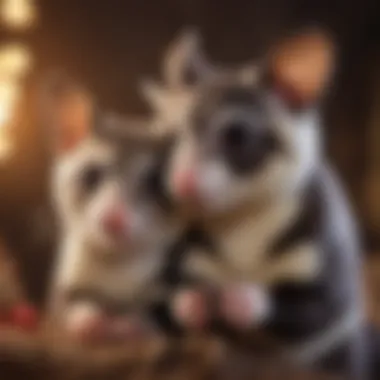

In addition to the cage, consider the following:
- Bedding: Use safe and absorbent materials, such as recycled paper bedding or aspen shavings. Avoid cedar or pine shavings, as these can be harmful.
- Hiding Spots: Sugar gliders enjoy having places to hide. Include fabric pouches or compartments where they can feel secure.
- Perches and Climbing Structures: Incorporate branches, ropes, and ladders to allow for climbing. This simulates their natural habitat and encourages exercise.
Make sure to place the cage in an area that is quiet but still allows for interaction with family members. Avoid direct sunlight and drafts, as sugar gliders are sensitive to temperature changes.
Environmental Enrichment
Environmental enrichment is vital in keeping your sugar glider mentally stimulated and emotionally healthy. Boredom can lead to behavioral issues, so providing various forms of entertainment is crucial.
Consider these elements for enrichment:
- Toys: Offer diverse toys like chew toys, foraging toys, and exercise wheels. Rotate toys regularly to maintain interest.
- Safe Materials: Use untreated wood, sisal ropes, and fabric as new materials for toys. Avoid plastics that can break easily.
- Foraging Opportunities: Hide treats within their bedding or around their enclosure to encourage natural foraging behaviors. Use natural fruits and insects as treats, ensuring they are safe for consumption.
Important Note: Always supervise your sugar glider when introducing new items to their environment. This ensures their safety and helps them become familiar with changes gradually.
By addressing habitat setup and environmental enrichment, you can create a nurturing environment that supports your sugar glider’s health and overall happiness. Your initial efforts in preparing your home will contribute to a long-lasting and fulfilling relationship with your new pet.
Diet and Nutrition
A proper diet is critical in the care of sugar gliders. These small marsupials have specific nutritional needs that directly affect their health and longevity. Understanding their dietary requirements helps to prevent health issues and ensures they lead a vibrant life. Nutrition not only supports their physiological functions but also influences behaviors and social interactions. Potential owners must be well-informed about what constitutes a balanced diet for sugar gliders, including the variety of foods that can be included, frequency of feeding, and appropriate portion sizes.
Basic Nutritional Needs
Sugar gliders require a well-rounded diet that includes protein, fruits, and vegetables. Protein can come from several sources such as insects, cooked eggs, or even specific commercial pelleted foods designed for sugar gliders. It is advisable to aim for a protein intake to make up about 25% of their diet. Fruits provide essential sugars and vitamins. Common choices include apples, bananas, and berries; these should comprise around 50% of their daily intake. Lastly, vegetables like carrots and leafy greens should be offered as well, making up the remainder of their diet. To ensure balanced nutrition, supplementation with vitamins and minerals is often necessary.
Common Food Sources
Choosing the right food for sugar gliders can be daunting initially. Here are some common food sources:
- Fruits: Apples, pears, grapes, and blueberries are favored. Avoid citrus fruits as they can upset their stomach.
- Vegetables: Carrots, zucchini, and sweet potatoes are suitable.
- Proteins: Crickets, mealworms, and cooked chicken or eggs are excellent options.
- Commercial Foods: Many brands produce specially formulated foods for sugar gliders. Notable examples include Sunseed Vita Prima or Oxbow products.
Each of these food types provides essential nutrients and should be rotated regularly to prevent dietary boredom.
Feeding Frequency and Portion Sizes
Feeding sugar gliders is somewhat unique due to their nocturnal nature. It is best to feed them in the evening when they are most active. Offering food in the evening also allows them to explore and engage with their meals. As for portion sizes, a general guideline is to offer approximately one to two tablespoons of food per sugar glider each evening, adjusting based on individual needs and activity levels.
When introducing new food or adjusting portion sizes, it’s crucial to monitor their weight and condition closely. Overfeeding can lead to obesity, while underfeeding can result in malnutrition.
In summary, a thoughtful approach to the diet and nutrition of sugar gliders is fundamental for their well-being. By paying attention to their dietary needs, owners can ensure their sugar gliders are healthy and robust companions.
Health and Wellness
The health and wellness of sugar gliders play a crucial role in their quality of life. Ensuring that these pets are well-cared for helps prevent preventable diseases and enhances their lifespan. To successfully care for a sugar glider, understanding their specific health needs and identifying signs of potential health issues is essential. This section details common health problems, routine veterinary care, and signs of illness to monitor.
Common Health Issues
Sugar gliders are generally healthy animals. However, they can face several health challenges, particularly if their care is inadequate. Some of the common health issues include:
- Obesity: Due to their active nature, they can easily become overweight if not provided proper diet and exercise.
- Malnutrition: An unbalanced diet can lead to nutritional deficiencies, which can affect their overall health.
- Dental issues: Sugars gliders may suffer from dental problems, resulting in pain and eating difficulties.
- Infectious diseases: Like other pets, they can fall victim to parasites and infections if not monitored and treated appropriately.
Recognizing these issues early can make a significant difference in treatment outcomes. A proactive approach to health management can greatly improve a sugar glider's well-being.
Routine Veterinary Care
Regular veterinary visits are essential for maintaining the health of any pet, including sugar gliders. Routine check-ups should be scheduled at least once a year. During these visits, veterinarians can perform:
- General health examinations: Assessing overall well-being.
- Dental examinations: Identifying any dental problems.
- Vaccinations: Preventing common diseases and infections.
- Nutritional assessments: Ensuring diet meets their specific needs.
It is also good practice to find a veterinarian who specializes in exotic pets. They will have the knowledge necessary to care for sugar gliders specifically, considering their unique physiology and behavioral traits.
Signs of Illness to Monitor
Monitoring sugar gliders for signs of illness can be challenging, as they often hide discomfort. Yet, there are key behaviors and symptoms to look for. Some signs of possible illness include:
- Changes in appetite: Eating less can signify health problems.
- Lethargy or inactivity: A noticeable drop in energy is often a signal that something is wrong.
- Abnormal vocalizations: Changes in their normal sounds can indicate stress or pain.
- Physical changes: Weight loss, changes in fur appearance, or lethargy can suggest health issues.
Keeping a close eye on your sugar glider's behavior and physical condition will help you respond quickly to any potential health issues, enhancing their quality of life.
Behavior and Training
Understanding behavior and training in sugar gliders plays a crucial role in creating a harmonious relationship between you and your pet. These small marsupials exhibit unique behaviors that are essential for their well-being. Fostering a positive environment through effective training can lead to better social interactions and minimize behavioral issues. Moreover, an informed approach to training helps owners understand what their sugar gliders need, making the experience enjoyable for both pets and owners.
Establishing Trust
Building trust with your sugar glider is the first step in behavior management. These animals are naturally instinctual and cautious, so creating a safe space is essential. Begin by spending quiet time near their habitat, allowing them to observe you without pressure. Avoid sudden movements or loud noises. Establishing a routine helps them feel comfortable around you. This means offering food at consistent times, which promotes predictability and safety.
You can also use treats to build a bond. Slowly introduce your hand in their environment, holding a preferred treat. Patience is key here; allow them to approach on their terms. Over time, they will associate your presence with positive experiences. Regular handling is important, as this reinforces trust. Spend time outside their cage in a secure area to allow exploration while you monitor their activity.
Basic Training Techniques
Training sugar gliders does not require sophisticated methods, but simple and consistent techniques yield significant results. Start with positive reinforcement. When introducing commands or desired behaviors, reward them with treats or verbal praise. This can engage their interest and encourage them to repeat the behavior.
Some effective training techniques can include:
- Target Training: Use a stick or your finger as a target. Reward them when they touch it. This can help in guiding them for trick training.
- Litter Training: These gliders can be trained to use a specific area for waste. Encourage this by placing comfortable bedding in that designated space and rewarding them for using it.
- Recall Training: Call your sugar glider's name or a specific command when they are in another room. Reward them when they return to you.
Consistency is vital in all training methods. Ensure that everyone in the household uses the same commands and rewards to eliminate confusion. Keep training sessions short, about five to ten minutes, to hold their attention without overwhelming them. Ultimately, the goal is to foster an intelligent and interactive companion.
Socialization Practices
Socialization is a vital element in the overall well-being of sugar gliders. These animals, while known for their affectionate nature, require proper interaction with both humans and other pets to thrive in a domestic environment. Understanding the nuances of socialization fosters a strong bond between pet and owner. Additionally, appropriate socialization prevents potential behavioral issues that can arise from lack of interaction or improper introductions.
Interacting with Humans
Sugar gliders are social creatures, naturally inclined to bond with their owners. Early and frequent interaction is essential. Start by allowing your sugar glider to acclimate to your presence. Speak softly and avoid quick movements, as sudden gestures may startle them. Gradually offer your hand so they can approach at their own pace.
Tempt them with treats like small pieces of fruit or specialized sugar glider food. This method reinforces positive encounters. Regular handling exposes them to different textures and sensations, which is beneficial for their development. Aim for short interactions initially, extending the length as they grow more comfortable.
It’s important to observe their body language. Signs of stress include flattened ears or rapid breathing. If your sugar glider appears uncomfortable, it is crucial to give them space. Remember, patience is key in building trust with your pet.
Introducing to Other Pets
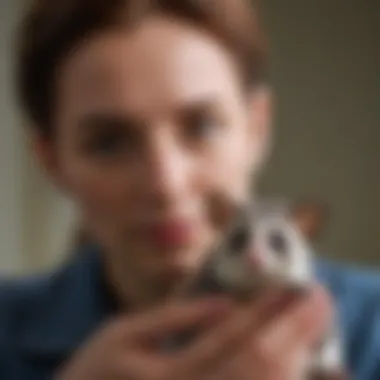
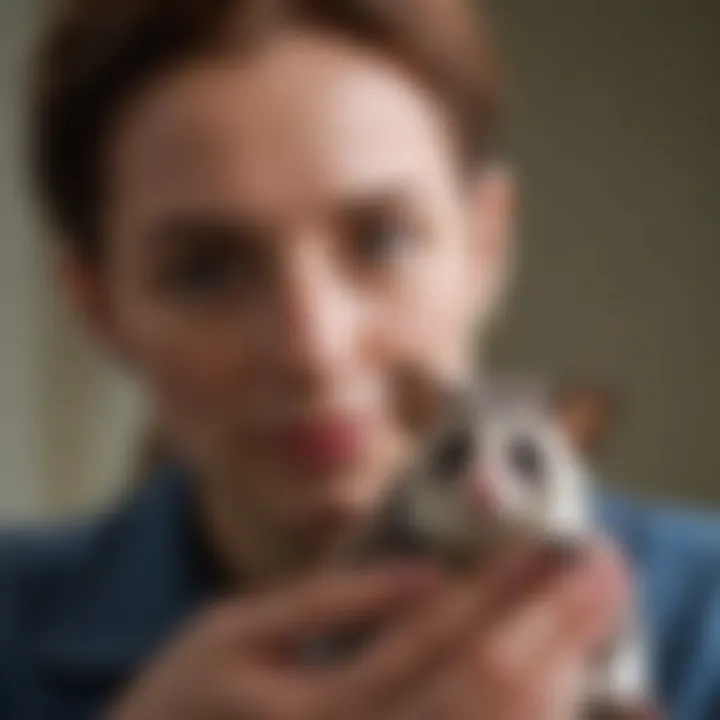
When socializing sugar gliders with other animals, caution is key. Not all pets are suitable companions. Introduce your sugar glider to other pets slowly and in controlled environments. Monitor each encounter closely. Always prioritize the safety of all animals involved.
Start by letting them observe each other from a distance. This observation can help reduce anxiety. Gradually allow closer interactions when both pets seem relaxed. Use a suitable barrier like a carrier for initial meetings.
Here are some tips for introducing sugar gliders:
- Choose the Right Pets: Peaceful animals, like certain small mammals or friendly cats, may adjust better to sugar gliders.
- Supervise Interactions: Never leave them unsupervised, especially during early introductions.
- Monitor Body Language: Look for signs of curiosity or distress in both animals to gauge their comfort levels.
"A well-socialized sugar glider can be one of the most rewarding companions you can have."
For more tips and community support, consider exploring social platforms like Reddit or Facebook groups focused on sugar glider care.
Utilizing online resources will enhance your understanding of sugar glider behavior and needs.
Creating a Long-Term Care Plan
A long-term care plan is essential for any prospective sugar gliders owner. These animals have specific needs that evolve over time. Developing a clear care strategy helps ensure that both the animal and the owner can thrive together. Ignoring this can lead to neglect, behavioral issues, and health problems.
When planning for long-term care, it is crucial to consider several elements:
- Daily routines: Structure helps sugar gliders adapt to their new home. Keeping consistent feeding times and play schedules is important.
- Social interaction: As social animals, sugar gliders need regular interaction. This can involve playtime outside the cage and bonding activities.
- Health management: Regular veterinary visits should be a scheduled part of the plan. Keeping vaccinations and health assessments in check is vital.
- Environment enrichment: Long-term care requires maintaining a stimulating environment. Providing a variety of toys and climbing structures helps keep these animals active and engaged.
By formulating a well-rounded care plan, you will not only meet the needs of your long-term companion but also improve your own understanding of their nuances.
Daily Care Routines
Establishing daily care routines is at the core of sugar glider management. These routines consist of feeding, cleaning, and socialization, all essential to their wellbeing. Sugar gliders are nocturnal, so care should be prioritized during the evening hours when they are most active.
- Feeding: Provide a balanced diet, including fruits, vegetables, and specialized diets like those from brands such as Mazuri or Exotic Nutrition. Offer fresh food daily to ensure high nutritional value.
- Cleaning: Clean the cage regularly to prevent odors and harmful bacteria. Spot clean daily and perform a deep clean weekly.
- Playtime: Engage them in short sessions. Use tunnels, ropes, or toys to stimulate their natural climbing and gliding behavior.
Routine stability can lead to better behavior and enhanced trust.
Emergency Preparedness
Emergencies can happen unexpectedly, making preparation crucial. A good plan can save your sugar glider’s life in a sudden health crisis, natural disaster, or other urgent scenarios.
- Vet information: Have a list of emergency veterinary contacts, including animal hospitals specializing in exotic pets.
- First-aid kit: Prepare a kit with essentials like antiseptic, gauze, and tweezers. Keep it accessible and up to date.
- Evacuation plan: In case of natural disasters, create a plan that includes a safe transport method and necessary supplies.
"Preparedness can make a significant difference in your pet’s health and safety."
Understanding these elements can greatly enhance group effectiveness in urgent situations.
By considering all facets of a long-term care plan, you can build a sound foundation for a lasting bond with your sugar glider. Comprehensive planning leads to an enriching pet ownership experience.
Understanding Sugar Glider Behavior
Understanding sugar glider behavior is crucial for anyone considering these unique animals as pets. Their social nature, nocturnal habits, and specific communication methods demand that potential owners be well-informed. Recognizing how they behave in different situations helps owners provide better care, ensure a harmonious household, and foster a positive relationship with their sugar gliders. By learning about their behavioral patterns, you not only enhance the well-being of your new pet but also enrich your own experience as an owner.
Nocturnal Patterns
Sugar gliders are primarily nocturnal creatures, meaning they are most active during the night. This behavior stems from their natural habitat in the wild, where they have evolved to forage and socialize after sunset. Understanding this trait is essential for owners because it affects their care routines.
- Activity Schedule: Expect them to be lively during the evening hours. However, this does not mean they sleep all day; they do have periods of wakefulness in the early morning and late afternoon.
- Lighting: Provide a dim-lit environment during their active hours. Bright lights can disturb them, leading to stress. Use soft lamps or low-intensity illumination to create a comfortable atmosphere.
- Playtime: Engage with them during their active periods. This can involve interactive toys or free roaming in a safe space where they can glide and climb.
Incorporating these considerations into your care strategy can significantly impact your sugar glider's happiness and health.
Vocalizations and Body Language
Understanding the vocalizations and body language of sugar gliders is another vital aspect of their behavior. They communicate a range of emotions and needs through various sounds and movements.
Some common vocalizations include:
- Crabbing: A harsh sound indicating distress or discomfort.
- Chirping: Often a sign of happiness and contentment.
- Whispering: Sometimes a comforting sound, signaling peace with their surroundings.
Observing their body language further complements your understanding:
- Tail Position: A high tail can indicate excitement or curiosity, while a low tail may signal fear or submission.
- Paw and Nose Displays: Sugar gliders often explore their environment with their paws and noses. A sudden stop in exploration could mean they are uncertain or apprehensive about something in their surroundings.
Understanding these vocal signals and body movements is key to developing a deeper bond with your pet. The more you learn about their communication, the better equipped you will be to respond to their needs.
In summary, grasping the nocturnal tendencies and communicative behaviors of sugar gliders helps owners provide tailored care. This knowledge supports their natural instincts, leading to a better quality of life for these fascinating creatures.
Travel and Transport Considerations
Traveling with a sugar glider requires special attention to ensure their safety and well-being. These animals are sensitive and require specific conditions during transport. A clear understanding of the necessities for travel can enhance the experience for both the owner and the pet. Factors like stress reduction and comfort play a significant role in this process.
Traveling with Your Sugar Glider
When planning to travel, it is crucial to consider the mode of transportation. Whether by car, airplane, or train, the environment should be suitable for a sugar glider. Here are essential points to keep in mind:
- Carrier Selection: Use a secure, well-ventilated carrier that allows your sugar glider to be comfortable. Ensure that the interior has minimal space for them to move around to avoid injury.
- Acclimatization: Before embarking on a journey, allow your sugar glider ample time to become familiar with the carrier. This reduces anxiety and stress during travel.
- Duration of Travel: If the journey is lengthy, take frequent breaks. This allows your sugar glider to hydrate and calm down from travel-related stress.
- Temperature Control: Maintain a comfortable temperature within the carrier. Avoid direct sunlight or drafts to protect your sugar glider.
"The comfort of your sugar glider during travel cannot be overstated. It directly affects their health and happiness."
Transport Safety Protocols
Adhering to safety protocols is vital for secure travel. Here are key considerations to implement:
- Identification: Ensure that your pet has proper identification. A collar with an ID tag or a microchip can facilitate their return if lost.
- Prevent Escape: Double-check that the carrier is securely fastened. An escaping sugar glider can cause panic and harm.
- Health Precautions: Before travel, visit a veterinarian for a health check. Ensure that your sugar glider is fit for travel, especially if crossing state lines.
- Emergency Kit: Pack an emergency kit containing water, a small blanket, and food. This ensures immediate access to care if needed during travel.
Support and Resources
Understanding the importance of support and resources is essential for any pet owner, especially when it comes to unique pets like sugar gliders. The journey of bringing a sugar glider into your home involves several considerations. This section will highlight how communities, literature, and other resources provide invaluable assistance in ensuring a healthy and rewarding relationship with these small marsupials.
Being a responsible pet owner means staying informed. As sugar gliders have specific needs, continuous learning is crucial. Online communities, forums, and literature not only provide information but also offer emotional support through shared experiences and knowledge from fellow owners. Engaging with these resources aids in making informed decisions about care practices, health management, and social interactions.
Online Communities and Forums
Online communities and forums serve as a primary resource for sugar glider owners. These platforms allow individuals to connect with others who share similar interests and experiences. Places like Reddit and Facebook host groups dedicated to sugar glider ownership. Members of these communities often share personal stories, tips, and advice on various aspects of care. Here are some benefits of participating in these online spaces:
- Shared Knowledge: Owners frequently post their experiences, which can provide practical insights into common challenges and solutions.
- Support Network: When facing difficulties, having a community to turn to for emotional support can be invaluable. You will find encouragement and camaraderie.
- New Trends and Practices: Keeping up with current trends in sugar glider care can be easier. Communities often discuss new diets, toys, or training methods.
- Problem Solving: If a sugar glider shows unusual behavior, asking the community for advice can lead to quick resolutions.
However, it's essential to discern credible information from anecdotal evidence. While personal stories enrich discussions, factual data is crucial. A well-moderated forum can help filter valuable advice from less reliable sources.
Books and Reference Materials
Books and reference materials are vital components of a comprehensive learning strategy for sugar glider owners. Authoritative texts can provide in-depth information that often extends beyond online advice. Reliable books can cover a range of topics, including:
- Care Requirements: Texts like "Sugar Gliders: The Complete Owners Manual" provide detailed information on habitat, diet, and health care needs.
- Behavioral Insights: Understanding sugar glider behavior is crucial. Comprehensive guides can explain nuances in social structures and anxiety triggers.
- Training Techniques: Learning how to train your pet effectively ensures a better bond and a more manageable pet. Books often outline structured training methods.
Investing in quality literature can significantly enhance your knowledge base. A careful selection of books offers not only guidelines but also a deeper understanding of the species. Libraries and bookstores usually have sections dedicated to pet care, making it easier to find reputable resources.















